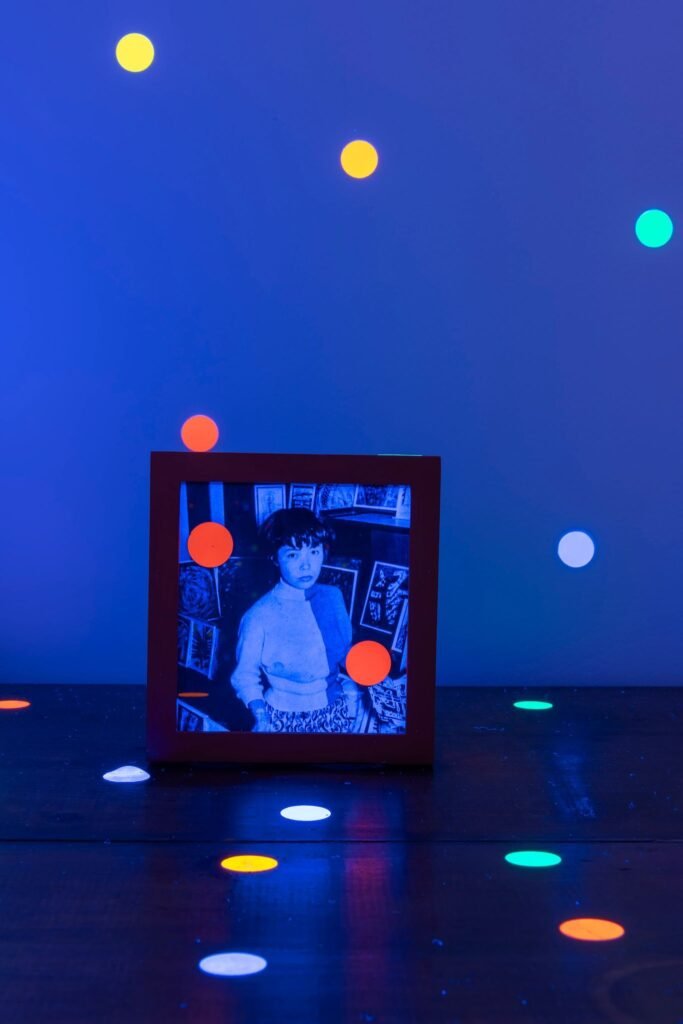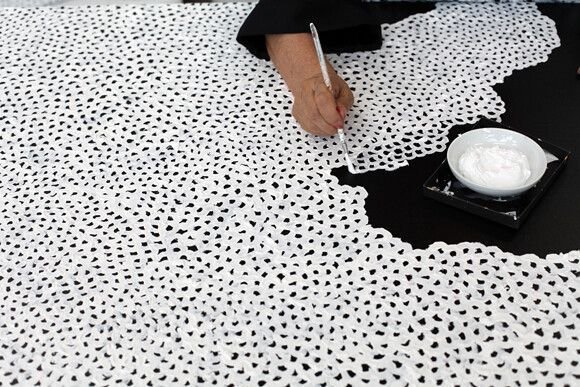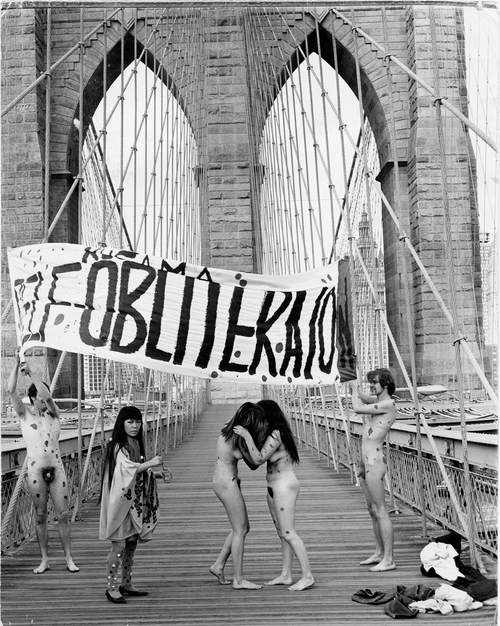GALERIA YAYOI KUSAMA
The architectural project of Galeria Yayoi Kusama was developed by architectsFernando Maculan (MACh) and Maria Paz (Rizoma). It encompasses an area of 1.436 m² located on the Orange Path, near Galeria Cosmococa and the Trails Garden.
Visitors arrive at the gallery via a stone path and a garden of tropical plants. The landscaping project was carried out by Juliano Borin, Inhotim’s botanical curator, Geraldo Farias, from Inhotim’s botanical garden team, with contributions from Bernardo Paz.

Galeria Yayoi Kusama at Instituto Inhotim
About the works
“In both works, with distinct appearances, Yayoi Kusama bases herself on the concept of Self-Obliteration, which the artist has been investigating in her work over many decades. The idea is to think about the dissolution of individualism, seeking a communion with the universal, blurring the boundaries of what is artwork, space, body and landscape” explains Inhotim curator Douglas de Freitas.
Imagined in 2000, the immersive installation I’m Here, But Nothing (2000) recreates the interior of an apartment with various objects and furnishings such as a sofa, television, table, chairs, picture frames, carpets and other decorative objects. The room is illuminated by black light (UV-A, ultraviolet), which highlights countless fluorescent coloured dots on the walls (these are stickers). The visitor’s perception is disturbed. This is a reference to the concept of Self-Obliteration. The installation may also reflect the hallucinations from which the artist suffered from a very early age. She described being struck by haunting visions of vast proliferations of dots, nets and flowers that overtook everything, including herself. “My room, my body, the entire universe was filled with [patterns], my self was eliminated, and I had returned and been reduced to the infinity of eternal time and the absolute of space. This was not an illusion but reality” (Y. Kusama).

Yayoi Kusama
I’m Here, But Nothing, 2000
Stickers, ultraviolet fluorescent lights, furniture, household objects
Aftermath of Obliteration of Eternity (2009) is also based on the principles of Self-Obliteration. Visitors are invited to enter a dark room filled with mirrors – giving the impression of infinity – and lit by lanterns that fade as their perception moves further away from reality. In this immersive environment, the viewer is transported into a universe completely different from the outside world.
“In the human world, what arouses our body and feeling of vitality is Eternity. I have been living in this Eternity, where enormous love for humanity passes through and the vast brilliance of life is infinitely reflected. . . . We keep flashing, disappearing, and again blossoming out in this Eternity.” Yayoi Kusama.

Yayoi Kusama
Aftermath of Obliteration of Eternity, 2009
Mirror, wood, plastic, acrylic, LED, aluminum
“Each work [exhibited at the Instituto] embodies a distinctly different environmental expression of the artist’s creative universe: the optical transformation of a darkened room into a psychological place of sensory overload; a contemplative infinity room; and a garden of suspended flotation composed of countless metallic spheres hovering above the natural landscape of Inhotim. Galeria Yayoi Kusama embodies the highest goals of Inhotim to provide unique environments for the experience of exceptional large-scale artworks for a wide-ranging and diverse audience”, explained Inhotim
Co-Founder Allan Schwartzman.

Yayoi Kusama
I’m Here, But Nothing, 2000
Stickers, ultraviolet fluorescent lights, furniture, household objects
In addition to these two new works, the Instituto Inhotim is exhibiting another installation by Yayoi Kusama, for several years. This is a version of the emblematic Narcissus Garden, first presented at the Venice Biennale in 1966. In a reference to the myth of Narcissus, who is charmed by his own image reflected on water, the installation gathers 750 stainless steel spheres on a reflecting pool.

Yayoi Kusama
Narcissus Garden, 1966/2009
Stainless steel
Yayoi Kusama
Yayoi Kusama was born in Japan in 1929. She experienced her first hallucinations at the age of 10. First in nature, then at a dinner where the floral motifs on the tablecloth took over the room. It was at this age that she began to paint and draw.

Yayoi Kusama, in 1939
In 1941, Pearl Harbor was attacked and Japan joined the Second World War. Yayoi Kusama took part in the war effort, working in a textile factory making parachutes and military uniforms.
In 1945, at the age of 16, she won a painting competition. She then studied at various art academies, where she was particularly introduced to nihonga painting – an artistic movement that emerged during the Meiji era and favored natural materials (wood, silk, paper) and water and ink paints. In 1952, her solo exhibition in her hometown of Matsumoto was a success and she began to exhibit in Tokyo and other Japanese cities.
In 1957, she moved to the United States to meet other artists, especially Georgia O’Keeffe, with whom she had exchanged letters before leaving. She settled first in Seattle and then in New York. She had little money and painted tirelessly for a new public who did not know her. In 1959 she exhibited her Infinity Nets Paintings.

Yayoi Kusama painting a canvas from the Infinity Nets series.
She explored new forms of art such as sculpture and installation. She was one of the first artists to propose immersive experiences. In particular, she introduced mirrors, emphasizing the loss of reference points and the perceptual experience for the viewer.
The dot motif became her signature. She exhibited alongside avant-garde artists such as Claes Oldenburg and Jasper Johns. Her work was acclaimed by Donald Judd and she was considered a pioneer of Pop Art. In 1960, she signed her Manifesto on Self-Obliteration.

Yayoi Kusama
Infinity Mirror Room, 1965
Sewn stuffed fabric, wooden panel, mirror
250 x 455 x 455 cm
She began her first happenings in 1966. Nudity was central to her performances, which supported the hippy movement.

The Anatomic Explosion happening held at the New York Stock Exchange, 1968
Uninvited, she took part in the Venice Biennale in 1966 with Narcissus Garden.
Yayoi Kusama, Narcissus Garden, Venice Biennale, 1966. Kusama offered the 500 mirrored balls for sale at 1200 lire ($2 each).

Yayoi Kusama, Narcissus Garden, Venice Biennale, 1966. Kusama offered the 500 mirrored balls for sale at 1200 lire ($2 each)
In 1967, she made the film Kusmama’s Self Obliteration.

From Self-Obliteration, 1968, a film by Yayoi Kusama & Jud Yalkut
Colour, Sound, 16 mm, 24 mins

Yayoi Kusama’s New York studio, 1968
She returned to Japan in 1973. She continued to suffer from her mental problems and the loss of her friend Joseph Cornell. In 1977 she asked to be committed. She still lives in this psychiatric hospital, where a studio has been set up for her. She now works with a large team of assistants.
In 2022, her trunover over the year (at auction) was $161.838.489, putting her in 12th place in the turnover rankings. In 2021, she was the first woman to break into the top 10 by turnover.

Yayoi Kusama’s turnover year by year
Her auction record stands at $10.5 Million, a figure achieved for a 1959 Infinity Net paining, Untitled (Nets) sold at a hammer price of $8.8M, against an estimate of $5M-$7M, at Phillips New-York in May 2022.

Yayoi Kusama
Untitled (Nets), 1959
Oil on canvas
130 x 116 cm
Estimate $5.000.000 – 7.000.000
Sold for $10.496.000 Phillips New-York, May 2022
Yayoi Kusama is one of the world’s most popular and influential contemporary artists. From her signature polka dots to her Infinity Rooms of mirrors and light, the artist’s multi-dimensional practice elevates her work to the status of an immersive experience for the viewer. Kusama has fused and transcended the aesthetics and theories of many late 20th-century movements, including Pop Art and Minimalism, creating her own path in an entirely innovative practice. She has exhibited all over the world, and collaborated with luxury houses such as Louis Vuitton. Today, she is one of the most sought-after artists on the art market.